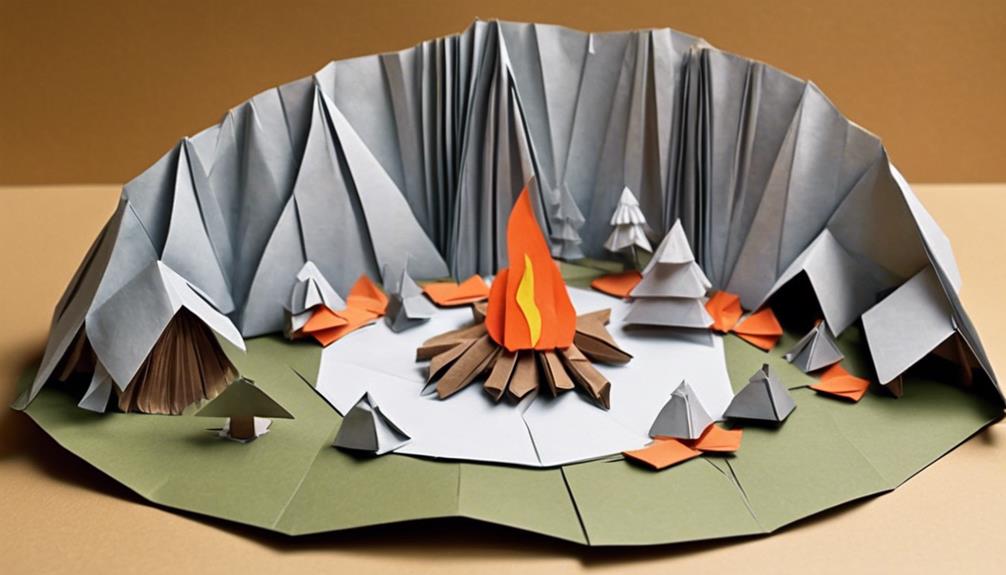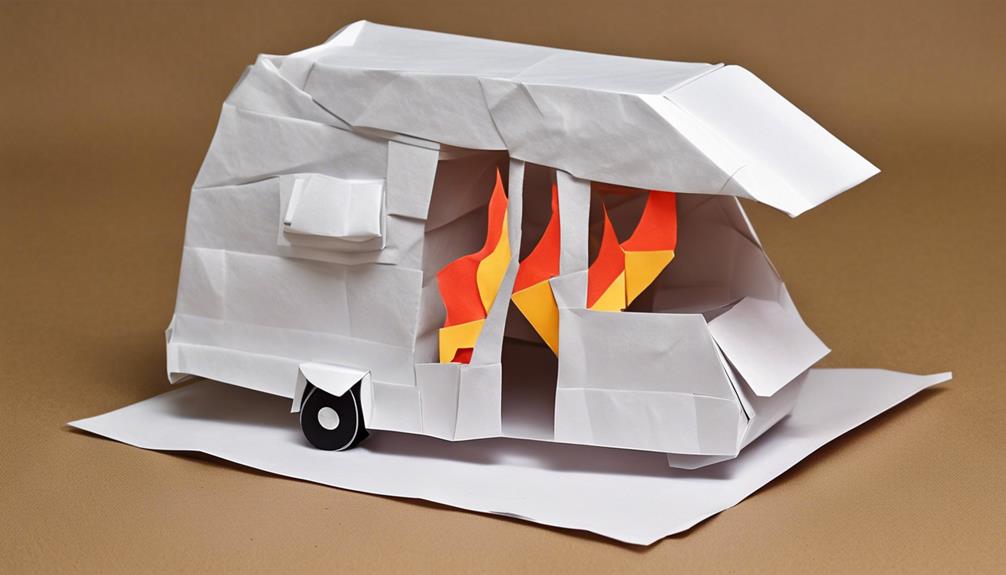Imagine you're sitting around a crackling campfire, the warmth enveloping you as the flames dance in the night. Now, envision the peace shattered by a sudden gust of wind, causing embers to scatter dangerously close to dry brush. In such moments, being equipped with essential fire safety knowledge can mean the difference between a memorable trip and a disastrous one. Explore the crucial tips and practices that will ensure your outdoor adventures remain safe and enjoyable.
Campfire Safety Guidelines

When starting a campfire, always remember to follow these essential safety guidelines. Begin by checking if the campsite allows fires and if there is a designated fire ring. If there is a fire ring, use it; if not, create a safe spot by clearing away any debris and building a ring with rocks. This is important for fire safety and environmental protection. When selecting firewood, opt for locally sourced wood to prevent the spread of pests and diseases. Avoid using wood that is treated, painted, or produces a lot of smoke.
Campfire safety is crucial. Keep a bucket of water or a fire extinguisher nearby in case the fire gets out of control. Additionally, having a fire blanket can help smother small flames quickly. Remember to never leave the fire unattended, and always fully extinguish it before going to bed or leaving the campsite. By following these guidelines and practicing proper fire ring etiquette, you can enjoy a safe and responsible campfire experience.
Choosing the Right Campsite
For a safe camping experience, selecting the right campsite is essential. When choosing a campsite, consider the terrain selection and safety considerations. Look for level ground to set up your tent to avoid rolling during sleep. Avoid areas prone to flooding or with loose rocks that could pose a hazard. Ensure there are no overhanging dead branches that could fall during windy conditions.
Evaluate shelter options based on the weather factors. If expecting rain, pick a spot with natural windbreaks like trees or rocks. In hot weather, choose a campsite with ample shade to stay cool. Be mindful of potential hazards like ant hills or poison ivy when setting up camp.
Before pitching your tent, scan the surroundings for potential dangers like cliffs or animal tracks. Remember that a good campsite not only provides comfort but also ensures your safety throughout your outdoor adventure.
Fire Starting Techniques

When starting a fire in the great outdoors, it's crucial to know safe methods for lighting fires and have essential tools on hand. Understanding the proper techniques and tools can make the process easier and safer for you and your surroundings. Let's explore some effective ways to start a fire while camping or enjoying outdoor activities.
Safe Fire Lighting Methods
To safely light a fire outdoors, it is essential to master reliable fire starting techniques. Here are some tips to help you safely light a fire during your outdoor adventures:
- Use proper tinder: Start with small, dry materials like twigs, leaves, or birch bark to ignite the fire effectively.
- Build a fire lay: Arrange your firewood in a way that allows for good airflow, such as a teepee or log cabin structure.
- Consider fire starters: Pack waterproof matches, lighters, or fire starters to ensure you have reliable ignition sources.
- Practice fire safety: Always have water or a shovel nearby to extinguish the fire completely before leaving the area.
Mastering these techniques will help you enjoy safe and successful fires while camping or exploring the outdoors.
Essential Fire Tools
You'll want to equip yourself with essential fire tools to ensure successful fire starting techniques during your outdoor adventures. When it comes to fire tool maintenance, make sure to keep your tools clean and dry to guarantee they function properly when needed. Emergency preparedness is key, so always carry multiple fire-starting tools like waterproof matches, lighters, and a fire starter kit. Practice using different fire starting techniques such as using a fire starter rod or learning how to properly build a fire lay. Knowing how to utilize your tools effectively in various conditions will be crucial for staying warm and cooking food while in the great outdoors.
Safe Cooking Practices
When cooking outdoors, always remember to use your stove properly and have a fire extinguisher handy in case of emergencies. These two essentials can help prevent accidents and ensure your safety while preparing meals in the wilderness. Stay prepared and cook safely to enjoy your outdoor adventures to the fullest.
Proper Stove Use
For safe cooking practices while camping, always remember to properly use your stove following manufacturer instructions and guidelines. When using your camping stove, consider the following tips:
- Use the correct fuel: Ensure you are using the appropriate fuel type recommended by the manufacturer to prevent accidents.
- Maintain proper ventilation: Always use your stove in well-ventilated areas to avoid carbon monoxide buildup.
- Keep a safe distance: Maintain a safe distance between the stove and any flammable materials to prevent fires.
- Never leave unattended: Always stay present while the stove is in use and never leave it unattended to prevent accidents.
Following these tips will help ensure a safe and enjoyable cooking experience during your outdoor adventures.
Fire Extinguisher Essentials
Make sure to have a fire extinguisher readily available and familiarize yourself with its proper use for safe cooking practices while camping. It's crucial to maintain your fire extinguisher by checking the pressure gauge monthly and ensuring there are no visible signs of damage. There are different types of fire extinguishers, categorized by letters like A, B, C, D, or K, each suitable for different types of fires. For camping and outdoor cooking, an ABC fire extinguisher is generally recommended as it can handle most common fires. Remember to keep your fire extinguisher within easy reach of your cooking area, and make sure everyone in your group knows where it is and how to use it in case of an emergency.
Extinguishing Fires Properly

To properly extinguish fires while camping, ensure that all flames are fully smothered and no embers remain glowing. It's crucial to follow these steps to prevent any accidental fires from reigniting:
- Spread Out the Ashes: Carefully spread out the ashes from the fire pit to expose any hidden embers.
- Pour Water: Slowly pour water over the ashes, stirring it with a shovel to douse any remaining embers thoroughly.
- Feel for Heat: Use the back of your hand to feel for any lingering heat above the ashes. If it's warm, continue to add water.
- Repeat if Necessary: Don't hesitate to repeat the process until everything is cool to the touch.
Properly extinguishing a fire is essential to prevent wildfires and ensure the safety of the environment and other campers. By taking these precautions, you can enjoy your camping experience knowing you've left no chance for a potential fire hazard.
Emergency Response Procedures
In case of an emergency while camping, it is crucial to be familiar with proper emergency response procedures to ensure the safety of yourself and others. Conducting emergency drills beforehand can help you prepare for unexpected situations. Establishing communication strategies with your camping group is vital. Make sure everyone knows how to reach emergency services and designate meeting points in case of separation.
During an emergency, remain calm and assess the situation quickly. If someone is injured, administer first aid if you are trained to do so. Contact emergency services immediately if the situation is beyond your control. Practice using emergency equipment like first aid kits and emergency flares before you need them.
Stay informed about potential risks in the area you are camping in, such as weather conditions or wildlife encounters. Always have a plan in place for different scenarios and communicate it with your camping companions. By being proactive and prepared, you can effectively handle emergencies and ensure the safety of everyone involved.
Frequently Asked Questions
Can I Use a Portable Fire Pit Instead of a Traditional Campfire?
You can definitely opt for a portable fire pit as an alternative to a traditional campfire. It's a convenient choice, but keep safety precautions in mind. Ensure the area is clear of any potential hazards like overhanging branches or dry grass. Always have a fire extinguisher or water source nearby. Remember to follow any local regulations or guidelines regarding the use of fire pits. Stay safe and enjoy your outdoor experience!
What Should I Do if I Encounter a Wildfire While Camping?
When you're out in the wilderness and encounter a wildfire, remember safety comes first. Follow evacuation procedures promptly and head towards designated emergency shelters. Keep calm and prioritize your well-being above all else. Quickly assess your surroundings and take necessary precautions to stay out of harm's way. Your swift actions could make all the difference in ensuring your safety during such a challenging situation.
Is It Safe to Cook Over an Open Flame With Aluminum Foil?
Cooking over an open flame with aluminum foil can be risky due to potential health hazards and environmental impact. Safe alternatives like using a grill or cast iron cookware are recommended. Aluminum foil may release harmful chemicals when exposed to high heat, affecting your food and the environment. Opting for safer methods not only ensures your well-being but also reduces your ecological footprint while enjoying outdoor cooking.
How Can I Prevent My Campfire From Attracting Wildlife to My Campsite?
You want to enjoy the great outdoors without unexpected visitors disrupting your campsite. To prevent your campfire from attracting wildlife, focus on wildlife management and campfire safety. Proper food storage and campsite hygiene are key. Keep food sealed and away from the fire, clean up any spills or food scraps, and dispose of trash properly. By being mindful of these details, you can create a safer and more peaceful camping experience for yourself and the wildlife around you.
Are There Any Specific Fire Safety Tips for Camping in Areas Prone to High Winds?
When camping in windy conditions, it's crucial to take safety precautions seriously. Secure your campfire area by clearing debris and creating a barrier. Have an emergency evacuation plan in place in case of a wildfire. Keep a close eye on the fire and never leave it unattended. Be prepared to extinguish it quickly if needed. Stay informed about local fire regulations and follow them diligently to ensure a safe camping experience.



